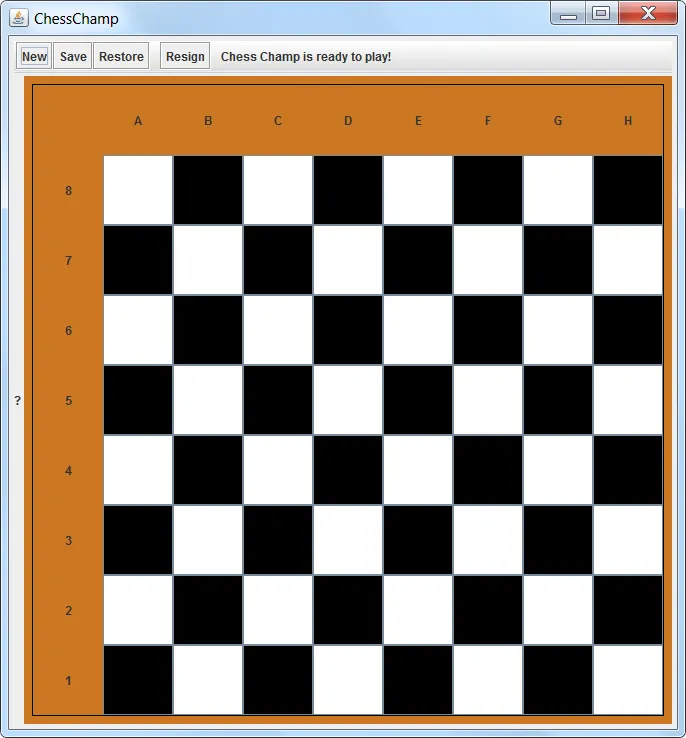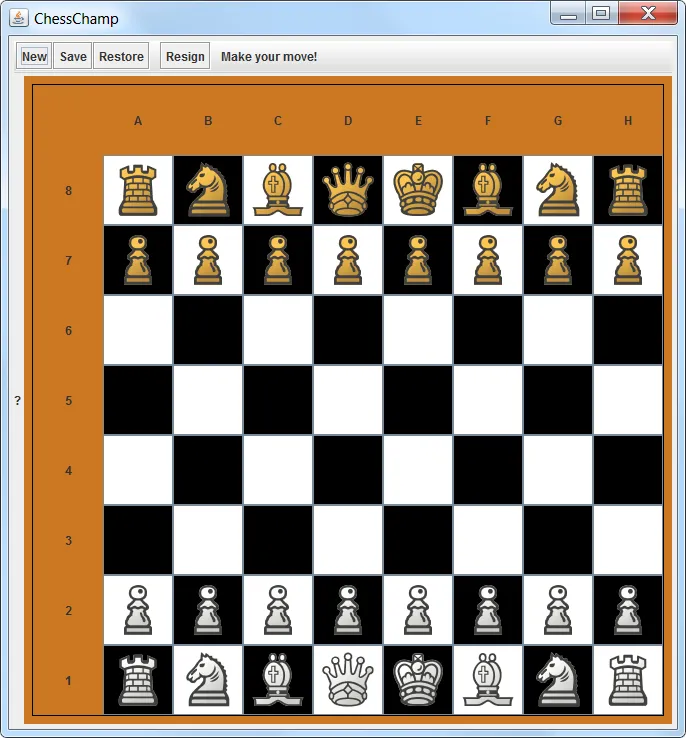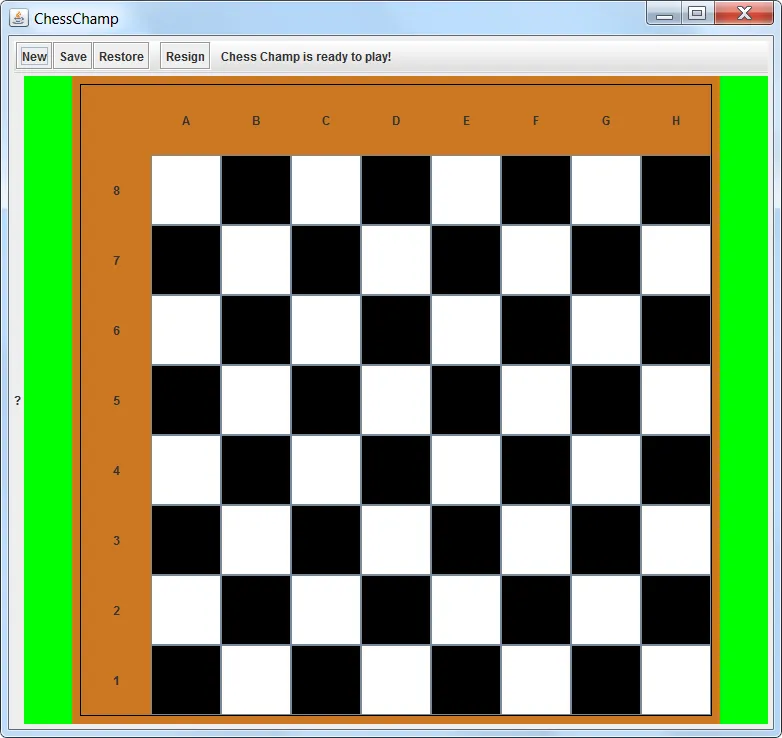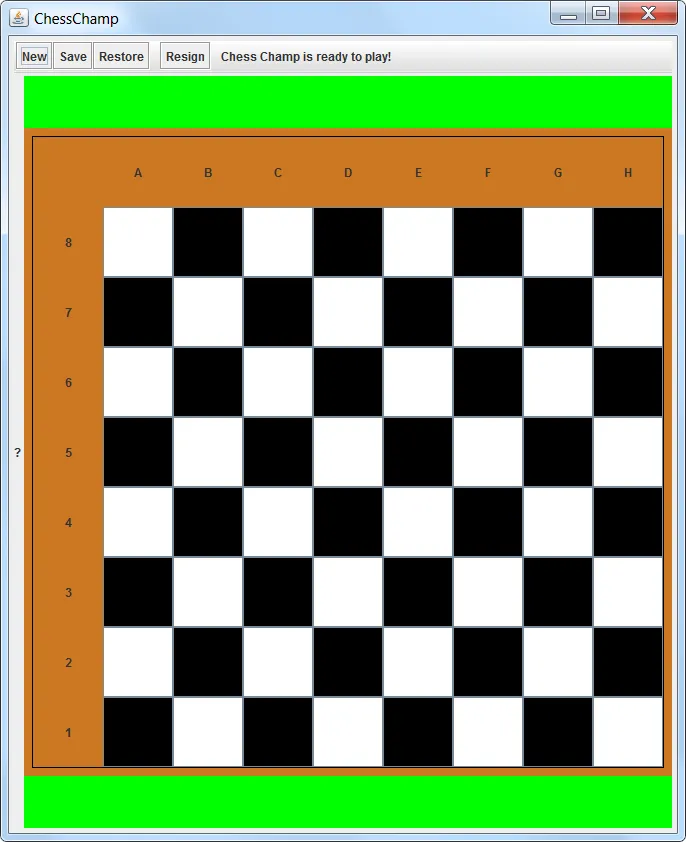我注意到,在调整大小时,棋盘与右侧/底部线边界之间可能会出现小间隙。这是由于网格布局不总是可以被9整除的空间导致的。
您可能正在寻找使用标准JDK的解决方案,但如果您想要消除这个小间隙,那么您可以使用
相对布局来管理棋盘和标签。间隙仍将存在,但我已将其移到标签上,所以您不容易看到差别。
import java.awt.*;
import java.awt.event.*;
import java.awt.image.BufferedImage;
import javax.swing.*;
import javax.swing.border.*;
import java.net.URL;
import javax.imageio.ImageIO;
public class ChessGUI2 {
private final JPanel gui = new JPanel(new BorderLayout(3, 3));
private JButton[][] chessBoardSquares = new JButton[8][8];
private Image[][] chessPieceImages = new Image[2][6];
private JPanel chessBoard;
private final JLabel message = new JLabel(
"Chess Champ is ready to play!");
private static final String COLS = "ABCDEFGH";
public static final int QUEEN = 0, KING = 1,
ROOK = 2, KNIGHT = 3, BISHOP = 4, PAWN = 5;
public static final int[] STARTING_ROW = {
ROOK, KNIGHT, BISHOP, KING, QUEEN, BISHOP, KNIGHT, ROOK
};
ChessGUI2() {
initializeGui();
}
public final void initializeGui() {
createImages();
gui.setBorder(new EmptyBorder(5, 5, 5, 5));
JToolBar tools = new JToolBar();
tools.setFloatable(false);
gui.add(tools, BorderLayout.PAGE_START);
Action newGameAction = new AbstractAction("New") {
@Override
public void actionPerformed(ActionEvent e) {
setupNewGame();
}
};
tools.add(newGameAction);
tools.add(new JButton("Save"));
tools.add(new JButton("Restore"));
tools.addSeparator();
tools.add(new JButton("Resign"));
tools.addSeparator();
tools.add(message);
gui.add(new JLabel("?"), BorderLayout.LINE_START);
chessBoard = new JPanel() {
@Override
public final Dimension getPreferredSize() {
Dimension d = super.getPreferredSize();
Dimension prefSize = null;
Component c = getParent();
if (c == null) {
prefSize = new Dimension(
(int)d.getWidth(),(int)d.getHeight());
} else if (c!=null &&
c.getWidth()>d.getWidth() &&
c.getHeight()>d.getHeight()) {
prefSize = c.getSize();
} else {
prefSize = d;
}
int w = (int) prefSize.getWidth();
int h = (int) prefSize.getHeight();
int s = (w>h ? h : w);
return new Dimension(s,s);
}
};
RelativeLayout rl = new RelativeLayout(RelativeLayout.Y_AXIS);
rl.setRoundingPolicy( RelativeLayout.FIRST );
rl.setFill(true);
chessBoard.setLayout( rl );
chessBoard.setBorder(new CompoundBorder(
new EmptyBorder(8,8,8,8),
new LineBorder(Color.BLACK)
));
Color ochre = new Color(204,119,34);
chessBoard.setBackground(ochre);
JPanel boardConstrain = new JPanel(new GridBagLayout());
boardConstrain.setBackground(ochre);
boardConstrain.add(chessBoard);
gui.add(boardConstrain);
ImageIcon icon = new ImageIcon(
new BufferedImage(48, 48, BufferedImage.TYPE_INT_ARGB));
Insets buttonMargin = new Insets(0, 0, 0, 0);
for (int ii = 0; ii < chessBoardSquares.length; ii++) {
for (int jj = 0; jj < chessBoardSquares[ii].length; jj++) {
JButton b = new JButton();
b.setMargin(buttonMargin);
b.setIcon(icon);
if ((jj % 2 == 1 && ii % 2 == 1)
|| (jj % 2 == 0 && ii % 2 == 0)) {
b.setBackground(Color.WHITE);
} else {
b.setBackground(Color.BLACK);
}
chessBoardSquares[jj][ii] = b;
}
}
RelativeLayout topRL = new RelativeLayout(RelativeLayout.X_AXIS);
topRL.setRoundingPolicy( RelativeLayout.FIRST );
topRL.setFill(true);
JPanel top = new JPanel( topRL );
top.setOpaque(false);
chessBoard.add(top, new Float(1));
top.add(new JLabel(""), new Float(1));
for (int ii = 0; ii < 8; ii++) {
JLabel label = new JLabel(COLS.substring(ii, ii + 1), SwingConstants.CENTER);
top.add(label, new Float(1));
}
for (int ii = 0; ii < 8; ii++) {
RelativeLayout rowRL = new RelativeLayout(RelativeLayout.X_AXIS);
rowRL.setRoundingPolicy( RelativeLayout.FIRST );
rowRL.setFill(true);
JPanel row = new JPanel( rowRL );
row.setOpaque(false);
chessBoard.add(row, new Float(1));
for (int jj = 0; jj < 8; jj++) {
switch (jj) {
case 0:
row.add(new JLabel("" + (9-(ii + 1)), SwingConstants.CENTER), new Float(1));
default:
row.add(chessBoardSquares[jj][ii], new Float(1));
}
}
}
}
public final JComponent getChessBoard() {
return chessBoard;
}
public final JComponent getGui() {
return gui;
}
private final void createImages() {
try {
URL url = new URL("http://i.stack.imgur.com/memI0.png");
BufferedImage bi = ImageIO.read(url);
for (int ii = 0; ii < 2; ii++) {
for (int jj = 0; jj < 6; jj++) {
chessPieceImages[ii][jj] = bi.getSubimage(
jj * 64, ii * 64, 48, 48);
}
}
} catch (Exception e) {
e.printStackTrace();
System.exit(1);
}
}
private final void setupNewGame() {
message.setText("Make your move!");
for (int ii = 0; ii < STARTING_ROW.length; ii++) {
chessBoardSquares[ii][0].setIcon(new ImageIcon(
chessPieceImages[0][STARTING_ROW[ii]]));
}
for (int ii = 0; ii < STARTING_ROW.length; ii++) {
chessBoardSquares[ii][1].setIcon(new ImageIcon(
chessPieceImages[0][PAWN]));
}
for (int ii = 0; ii < STARTING_ROW.length; ii++) {
chessBoardSquares[ii][6].setIcon(new ImageIcon(
chessPieceImages[1][PAWN]));
}
for (int ii = 0; ii < STARTING_ROW.length; ii++) {
chessBoardSquares[ii][7].setIcon(new ImageIcon(
chessPieceImages[1][STARTING_ROW[ii]]));
}
}
public static void main(String[] args) {
Runnable r = new Runnable() {
@Override
public void run() {
ChessGUI2 cg = new ChessGUI2();
JFrame f = new JFrame("ChessChamp");
f.add(cg.getGui());
f.setDefaultCloseOperation(JFrame.DISPOSE_ON_CLOSE);
f.setLocationByPlatform(true);
f.pack();
f.setMinimumSize(f.getSize());
f.setVisible(true);
}
};
SwingUtilities.invokeLater(r);
}
}
它需要更多的工作,因为您需要单独管理行,而不是在网格中。此外,我更改了您使用的代码,以便在我的较小显示器上更轻松地测试调整大小,使用48x48的图像。



